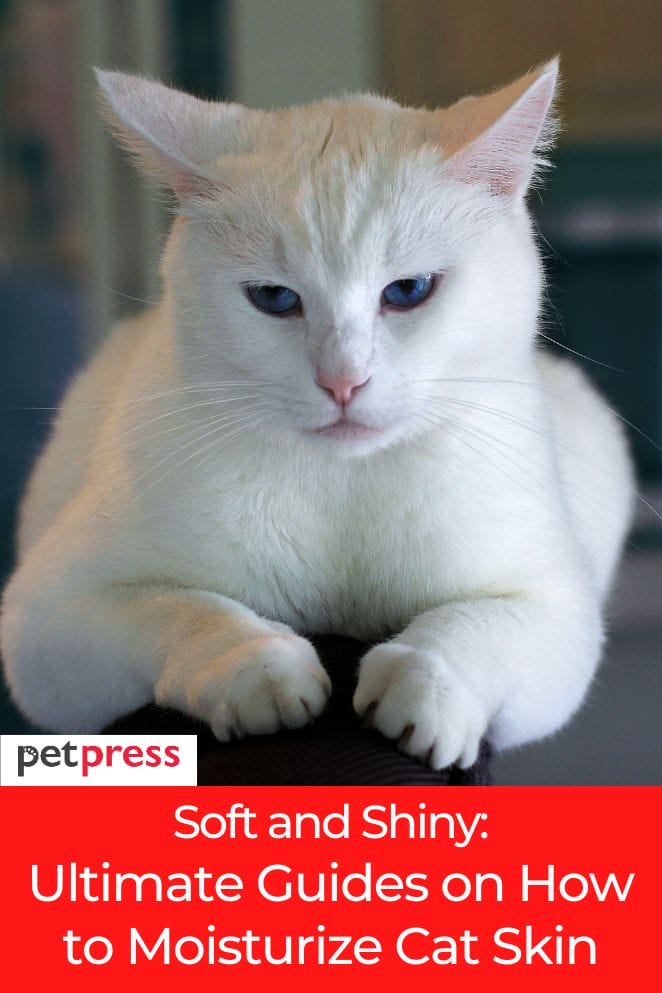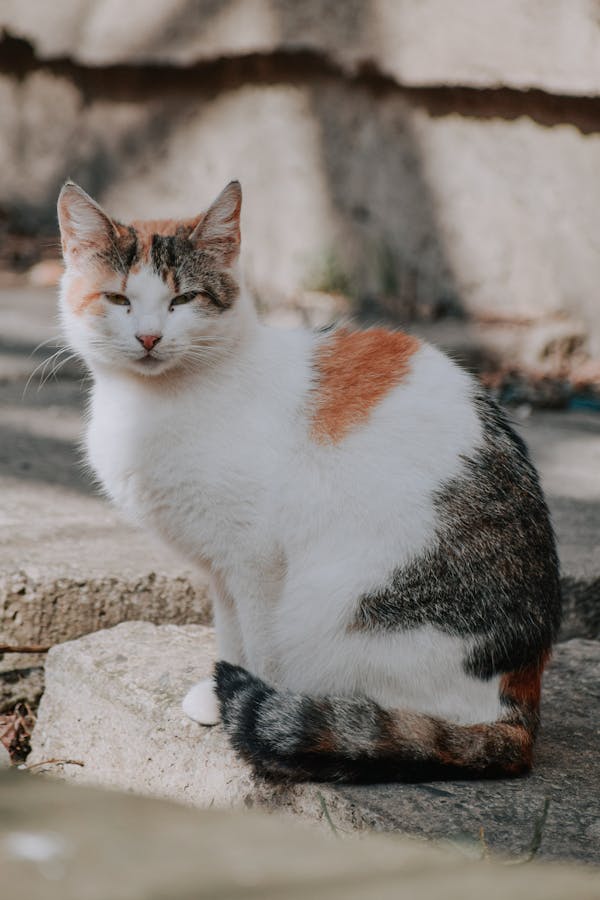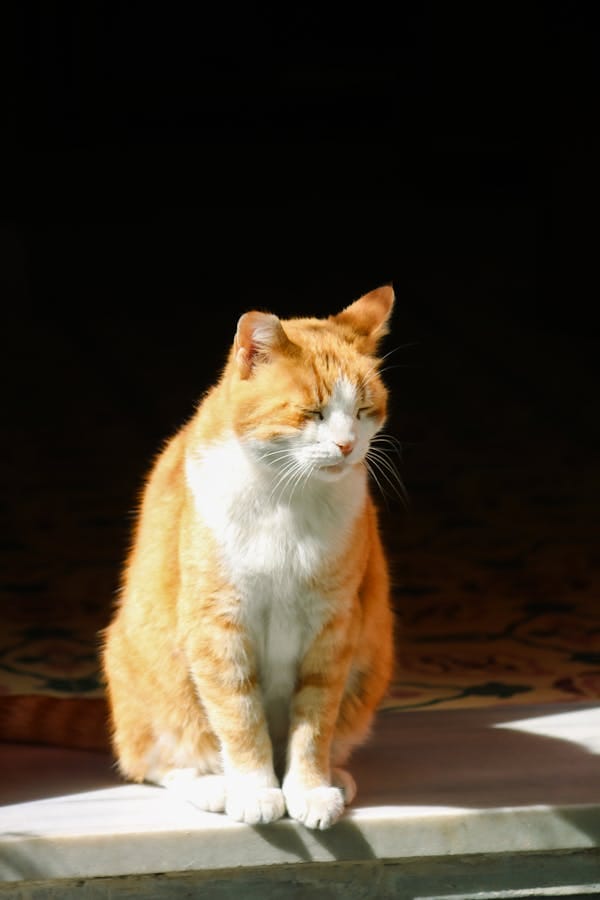
Just like humans, cats can suffer from dry skin, which can be uncomfortable and lead to further health issues if not addressed.
Knowing how to properly moisturize your cat’s skin can make a significant difference in their overall well-being.
In this guide, we’ll cover the signs and causes of dry skin in cats, and provide practical tips on how to moisturize your cat’s skin effectively.
Signs of Dry Skin in Cats
Recognizing dry skin in cats is important for keeping your feline friend comfortable and healthy.
Here are some common signs of dry skin to watch for:
Flaking
Dry skin in cats often appears as visible flakes on their fur, similar to dandruff in humans.
You might notice small white or grayish flakes on your cat’s coat, especially around their back or tail area.
This flaking can be a sign that their skin is not producing enough moisture.
Itching
If your cat is scratching more than usual, it could be a sign of dry skin.
Excessive scratching can lead to hair loss and skin damage.
Your cat might use their claws or teeth to scratch or bite at areas where their skin feels itchy or uncomfortable.
Redness
Inflamed or red patches on your cat’s skin can indicate dryness.
When the skin becomes irritated, it can turn red and look inflamed.
This redness may be found in areas where your cat scratches or licks frequently.
Dull coat
A healthy cat’s fur usually has a shiny and smooth appearance.
If your cat’s coat looks dull and dry, it might be due to dry skin.
The lack of natural oils can make their fur look lackluster and less vibrant than usual.
Excessive grooming
Cats often groom themselves to keep clean, but if your cat is licking or biting their skin excessively, it may be an attempt to relieve discomfort from dry skin.
This behavior can sometimes worsen the problem by causing more irritation or leading to hot spots.

Causes of Dry Skin in Cats
Understanding why your cat’s skin might be dry can help you choose the right treatment.
Here are some common causes of dry skin in cats:
Environmental factors
Dry air, especially during winter or in dry climates, can make your cat’s skin dehydrated.
Just like how dry air can affect human skin, it can also affect your cat’s skin, leading to dryness and flakiness.
Diet
A poor diet lacking essential nutrients can contribute to dry skin.
Specifically, if your cat’s diet doesn’t have enough omega-3 and omega-6 fatty acids, their skin might become dry and less healthy.
These fatty acids are important for maintaining healthy skin and a shiny coat.
Allergies
Allergies can cause skin problems in cats.
They might be allergic to certain foods, pollen, or other environmental factors.
These allergies can lead to skin irritation and dryness.
If your cat is scratching a lot or has inflamed patches, allergies could be the culprit.
Parasites
Parasites like fleas, mites, and ticks can cause dryness and irritation.
These pests often lead to itching and scratching, which can make the skin dry and damaged.
Regular parasite control is important to prevent these issues.
Medical conditions
Certain medical conditions can cause dry skin in cats.
For example, hypothyroidism (an underactive thyroid) and seborrhea (a skin condition that causes flaking and oiliness) can both lead to dry, flaky skin.
If you suspect a medical condition, it’s important to consult with your veterinarian for a proper diagnosis and treatment.

How to Moisturize Your Cat’s Skin
There are several ways to keep your cat’s skin moisturized and healthy.
Here’s a detailed look at each method:
Brushing
Regular brushing helps maintain your cat’s skin and coat health.
It removes dead skin cells and spreads natural oils throughout their fur, which can keep their skin healthy.
Use a brush that is appropriate for your cat’s fur type—whether short or long—and be gentle to avoid causing irritation.
Brushing not only helps with moisturizing but also reduces shedding and matting.
Dietary changes
Omega-3 and Omega-6 Fatty Acids
A diet rich in omega-3 and omega-6 fatty acids is crucial for maintaining healthy skin and a shiny coat.
These essential fatty acids can be found in:
- Oily fish: Fish like salmon, sardines, and mackerel are great sources of omega-3 fatty acids. You can offer these to your cat in moderation, but make sure they are cooked and free of bones.
- Flaxseed oil: Adding a small amount of flaxseed oil to your cat’s food can help boost their skin health.
- Specialized cat food: Many high-quality cat foods are formulated with added omega-3 and omega-6 fatty acids specifically for skin and coat health.
Topical treatments
Sprays
Moisturizing sprays designed for pets can offer quick relief for dry skin.
They’re easy to apply and can provide immediate moisture.
Always check with your vet before using any new product to make sure it’s safe for your cat.
Wipes
Moisturizing wipes are handy for spot treatments or for cats who don’t like sprays.
They can be used to gently hydrate areas of dry skin.
Choose wipes that are specifically made for pets to ensure they are safe and effective.
Leave-in conditioners
Leave-in conditioners can help maintain moisture in your cat’s coat and skin.
Apply the conditioner according to the instructions on the product.
Be cautious not to use too much, as your cat might lick off any excess, which could be harmful.
Moisturizing lotions
Pet-safe moisturizing lotions can be applied to dry areas.
Use these lotions sparingly and follow the instructions carefully.
Avoid over-applying, as cats might lick the lotion off, which can lead to ingestion of potentially harmful substances.
Humidifier
Using a humidifier in your home can help add moisture to the air, which is particularly useful in dry climates or during winter.
This added humidity can prevent your cat’s skin from becoming dry and flaky.
A humidifier can create a more comfortable environment for both you and your cat, helping to keep their skin hydrated.

Additional Tips
Regular vet check-ups
Regular veterinary check-ups are crucial for maintaining your cat’s overall health, including their skin.
Vet visits help identify and address any underlying medical conditions that could be causing dry skin.
Conditions like thyroid issues or allergies can contribute to skin problems, so regular check-ups help catch and treat these issues early.
Hydration
Keeping your cat hydrated is essential for maintaining healthy skin.
Make sure your cat always has access to fresh water. Proper hydration helps keep their skin and coat healthy from the inside out.
If your cat is not drinking enough water, consider adding a water fountain or wet cat food to encourage more fluid intake.
Flea control
Fleas and other parasites can cause itching and irritation, which can lead to dry skin.
Regular flea control treatments are important to keep your cat free from these pests.
Consult your vet for the best flea prevention methods and treatments to ensure your cat stays comfortable and healthy.
Bathing
While it might be tempting to bathe your cat frequently, it’s important to avoid doing so as it can strip their skin of natural oils.
Instead, only bathe your cat when absolutely necessary, using a mild, moisturizing shampoo recommended by your vet.
Frequent bathing can dry out your cat’s skin, so it’s best to keep baths to a minimum.

Conclusion
Dry skin in cats can be a discomforting condition, but with proper care and attention, it can be managed effectively.
By incorporating regular brushing, dietary changes, appropriate topical treatments, and ensuring a humid environment, you can help keep your cat’s skin healthy and hydrated.
Always consult with your veterinarian before starting any new treatment to ensure it’s safe for your furry friend.
- Can You Have a Meerkat as a Pet? Everything You Need to Know - November 25, 2025
- Emerald Tree Skink: Your Complete Guide to This Stunning Lizard - November 24, 2025
- How Much Are Ragdoll Cats? A Complete Guide - November 21, 2025


GIPHY App Key not set. Please check settings